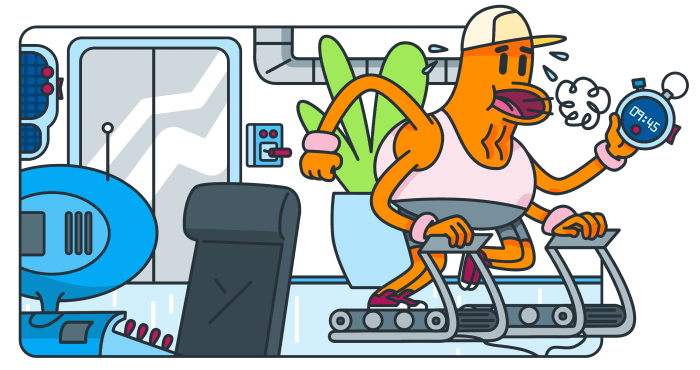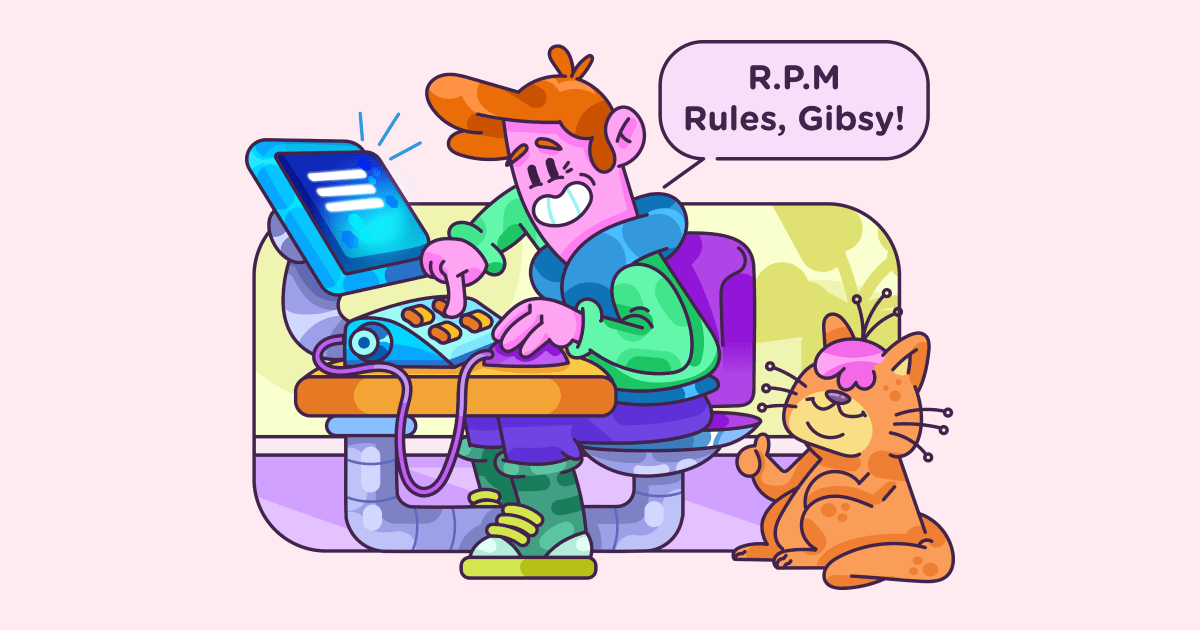Productive things to do within 10 minutes
Last updated on: March 31, 2022
You have 10 minutes to spare, but you don’t want to spend that time scrolling through social media or you just don’t feel like chilling right now.
You would rather do something productive.
What can you do in such a short period of time?
Worry not. In this article, we’ll go over a list of productive things you can do in 10 minutes (or less), whether you’re at work or home.

Table of Contents
Productive things to do with 10 minutes at work
Ten extra minutes at work are perfect for finishing the small tasks that we’re often too busy or too lazy to do, but that make our work life way smoother and less stressful.
Declutter your inbox
We’re usually buried in emails, both important and unimportant ones.
If you have a couple of minutes to spare, get your inbox to zero: answer the important emails, delete the ones that require no action nor contain important information, unsubscribe from the newsletter you’re no longer interested in.
If you get a lot of emails that require the same response, don’t keep typing the same thing over and over again: use this time to create templates for all of your recurring responses. Responding to emails will take you way less time.
Track your time
There are a couple of ways to track time: if you use a timer, it will take you no more than a couple of seconds to start it, but if you use timesheets, you might need a few minutes to add all of your daily tasks.
Time tracking is the most effective when you do it every day instead of once a week (or less often); according to Ebbinghaus’ Forgetting Curve, we retain only 23% of what we learned after six days.
You can also use 10 minutes to check the dashboard of your productivity tracker and analyze what you typically spend time on and if you should organize it differently.
💡 Are you working from home? You might find this blog post useful:
How tracking time can make you more productive while working from home
Set goals for the week ahead
Weekly goals are usually a part of a big, long-term goal broken down into smaller chunks. That’s why you should set them keeping the bigger picture in mind and knowing why you chose the specific goals you chose.
They’re not as intimidating as that long-term goal and they allow you to see your progress better than daily goals. You also have enough room to make adjustments if needed, but time is still short enough to keep you motivated.
Another thing to keep in mind is to plan the time needed to complete the tasks as accurately as possible; your time tracking data can help you with that.
Some people prefer to give themselves double the time they estimated is needed, which may work for you too. If everything else fails, always leave yourself a buffer of at least 1-3 days (depending on the task), just in case.
Write a to-do list
Writing to-do lists usually comes after setting goals; I decided I should respect that order in this blog post, too. While those two things are connected (along with the next thing we’re going to talk about), you can’t fit them all in 10 minutes – unless you’re really, really fast – each one of them usually takes around that time.
The most effective to-do lists are well-structured and don’t have too many tasks on them.
For the best results, don’t write more than 6-7 and give them priority levels: the most important things should get done first. If there’s something you can delegate, delegate it.
You can add a couple of nice-to-dos – tasks that would be nice to get done after (and if) you manage to accomplish the main ones.
It’s crucial to be specific when writing a to-do list. “Work on Project A” could mean many things; it’s better to write “Brainstorm ideas for ____” or “Assign tasks to the team” instead.
You can write daily or weekly to-do lists (or both!), whichever works best for you.
Evaluate your progress
We talked about analyzing the data you gathered by time tracking and evaluating how you spend your time; you can also analyze and evaluate your progress.
Check again what your goals are and how close (or far) you are to accomplishing them. Ask yourself if your daily actions reflect the goals you want to achieve. Is your strategy working? What aspects of it are making it work? If it’s not working, what do you think, why? What can you do to improve it? If you can’t make it work, what can you do instead?
This isn’t supposed to put you in a bad mood if you’re still nowhere near where you want to be, it’s a tool that will help you take the right set of actions and implement any changes if needed, so you can achieve everything you’re planning to.
Organize your workspace
Ten minutes is just enough time to either clean your desk or declutter your digital space.
When it comes to cleaning the desk, you should:
- Throw out empty coffee cups, water bottles, or anything else that shouldn’t be there.
- Organize your papers and throw out the ones you don’t need (generally, it’s a good idea to use less paper if possible).
- Put similar things together: pencils in the pencil holder, papers in one pile, sticky notes in the same corner of the desk, etc, so you always know where to reach for when you need something.
- Make a no parking zone – a space on your desk that is always empty and that you can’t put anything on, so you can always have enough space to write or put your keyboard.
If your desk is already clean and organized, you can declutter your phone or your computer. Delete all the files and apps you don’t use anymore and organize the ones you do.
Make a phone call
(Bonus points if you’ve been avoiding that phone call.)
Make that appointment you need to, have a short business call, or just give a quick call to a friend or family member to check up on them and see how they are doing.
Brainstorm for your new project
You can do this with your teammates or by yourself.
The most important rules of brainstorming are: no negative feedback/judgment, quantity over quality, wild ideas should be encouraged, as well as building on other people’s ideas.
There are many brainstorming techniques you can choose from. Here are some of the most frequently used:
- Write down as many ideas as you can in a limited amount of time (in that phase, it doesn’t matter if they’re good or not) and discuss them only after the time is up.
- Mind-mapping, where you draw the diagram that shows you relationships among and between ideas.
- Brainwriting, for when you’re brainstorming in a team. Everyone writes down 3 ideas on a piece of paper and then gives it to the person next to them to build on them. Once the ideas make their way around the table, you can discuss them and decide which ones are the best to implement.
Productive things to do with 10 minutes for self-improvement
You may think that 10 minutes isn’t enough time to better yourself, and you’re absolutely right – it isn’t. However, if you are consistent, 10 minutes a day equals around 5 hours a month, or 60 hours a year: that gets you way further than 0 hours.
Here are some things you can do for yourself in 10 minutes.
Read
Whether it’s an informative blog post or a couple of pages of a book, reading is always a time well spent. Reading will:
- Build your vocabulary,
- Mentally stimulate you,
- Improve your concentration and focus,
- Make you a better writer (all good writers are, first and foremost, good readers),
- Improve your memory,
- Reduce stress.
Studies also show that reading, along with solving math problems, has positive effects on cognitive functions.
But above all – it’s fun.
Take a walk
A ten-minute walk is just enough to catch some fresh air, improve your mood, and clear your head. This study shows that walking also boosts creative ideation in real time and shortly after, especially walking outdoors. As the study states, “Walking opens up the free flow of ideas, and it is a simple and robust solution to the goals of increasing creativity and increasing physical activity.”
If you have the opportunity to walk longer than only 10 minutes a day, even better. Walking 30 minutes a day “unlocks” even more benefits, such as boosting immune functions, burning calories, strengthening leg muscles and the heart, boosting your energy, and overall improving your health.
Move your body
If you can’t go outside for a walk, stretching or doing a few exercises are also good options. Our bodies are made to move and the sedentary lifestyle a lot of us live is neither natural nor healthy.
That’s why it’s important to take breaks from working and do some sort of physical exercise. It can be light, like yoga or stretching (it’s not the same thing!), or a little more strenuous: jumping rope, jumping jacks, burpees, squats, lunges, mountain climbers, etc.
Again, working out for 30-40 minutes gets you better results than 10 minutes, but if you have only 10, that’s just fine. When it comes to health, an all-or-nothing attitude serves no one: do whatever you can as something is always better than nothing.
Make a meal plan for the week
Eating healthy gets easier when you decide what are you going to eat beforehand, not when you’re already hungry. It also helps to buy groceries strategically instead of buying random things and then figuring out what meal you can make out of them.
Meal planning consists of:
- Figuring out what are you going to eat for every meal: breakfast, lunch, dinner, and snacks (if you want to be extra organized, you can even make a spreadsheet),
- Looking up the recipes (if needed),
- Making a shopping list,
- Preparing food (usually in advance).
Of course, you can’t do all of this in 10 minutes, but you can surely do step one; you can maybe even get to step number three, if you already know, more or less, how your weekly menu looks like.
Journal
When they hear journaling, many people think of diaries we had as kids (in my mind they’re always accompanied by the pink, fluffy pens and those cheap little locks).
The truth is that writing a journal is a great mindfulness practice for every age.
It clears your mind and keeps your thoughts organized; it also allows you to “brain dump” everything heavy that’s been on your mind, which reduces stress.
Another benefit is that it’s a great tool for self-reflection. Writing down your thoughts makes you simultaneously the one who speaks and the one who listens. If this sounds confusing, try it out, you’ll see what I mean.
Morning pages are a similar concept that I heard from a productivity Youtuber Amy Landino. Every morning when you wake up, before grabbing your phone, grab your notebook and write 3 pages of anything that’s on your mind. The only rule is that it has to be 3 pages, everything else is up to you: you can write it like a diary, in the stream-of-consciousness style, or in an entirely different way, whatever works best for you.
Watch a good Youtube video
The average Youtube video length is around 10 minutes, just enough to squeeze it between your daily tasks and learn something new in the process. Watch a video on a topic that interests you and you want to learn more about – there are plenty of videos that talk about productivity, psychology, language learning, motivation, or anything else you can think of. There are also tutorials on almost everything you can imagine (from making spaghetti to solving a complex mathematical problem), TEDx talks, podcasts, interviews with experts, and much more. Youtube doesn’t have to be just for entertainment.
Do a personality test
There are plenty of tests that can be found online and that focus on different parts of your personality. They vary in accuracy and shouldn’t be taken too seriously, but they can be a fun way to find out something new about yourself and get to know yourself better.
💡 Have you heard of the 16 personalities test? If you want to learn how to boost your productivity based on your MBTI personality type, check out our article on How to increase productivity based on your personality type.
Productive things to do with 10 minutes at your household
There’s always something that needs to be done around the house, whether it’s laundry, tidying up, cooking or something else – the list goes on and on. Things get messy again very fast (especially if you have kids) and taking care of everything can take an entire day.
However, even 10 minutes of doing chores make a difference. If you’re at home, here are some of the things you can do:
- Wash the dishes or empty the dishwasher,
- Vacuum one room in the house,
- Fold a load of laundry,
- Tidy up one room in the house,
- Cook a healthy meal,
- Go grocery shopping,
- Water your plants.
Conclusion
There are a lot of things you can do in only 10 minutes, whether you’re at home or work, whether you’re in the mood for cleaning, planning, or expanding your knowledge.
The ideas in this blog post are the most effective if you do them every day, but they will have positive effects even if you do them a couple of times a week or whenever you can. Every minute you put towards improving yourself and your work counts.
✉️ What do you prefer to do with 10 extra minutes? Do you have any ideas you would like to add to the list? Did you find anything you would like to try? Write to us at blogfeedback@clockify.me.





